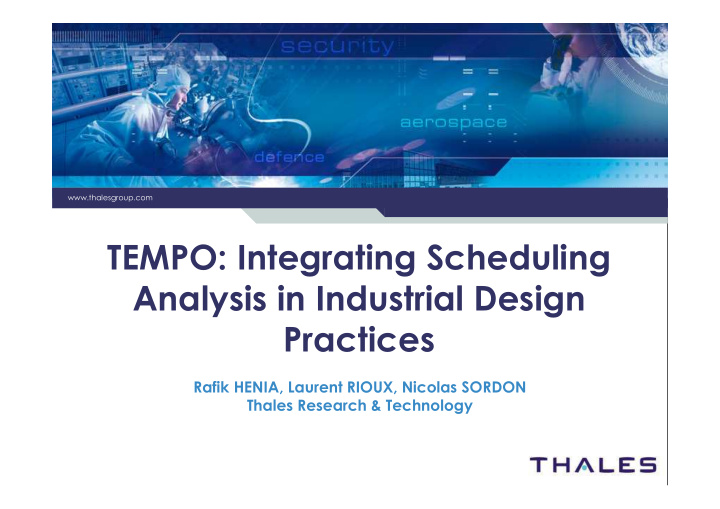



www.thalesgroup.com TEMPO: Integrating Scheduling Analysis in Industrial Design Practices Rafik HENIA, Laurent RIOUX, Nicolas SORDON Thales Research & Technology
How to Benefit from Existing Timing Analysis Techniques and Tools ? 2 / 2 / Modeling tools TAS TOSA/CAPELLA TCS Timing verification tools MAST Pro Cheddar SymTA/S RTAS’16 Conference – Vienna - 12 April 2016
Connecting Design to Timing Performance Verification 3 / 3 / Available in modeling tool Performance Viewpoint Different priorities order Modeling tool Application model & behavior semantic � Mapping � Timing characteristics � Scheduling characteristics � ? Different scheduling semantic Different task communication Required by analysis tool semantic Application model & behavior SymTA/S � Mapping � Timing characteristics � Scheduling characteristics � RTAS’16 Conference – Vienna - 12 April 2016
Solving the Semantic Gaps 4 / 4 / Task 1 Task 2 Timing behavior Modeling tool Task 1,a Task 2 Timing behavior SymTA/S Task 1,b RTAS’16 Conference – Vienna - 12 April 2016
Solving the Semantic Gaps 5 / 5 / Task 1 Task 2 Timing behavior Modeling tool Task 1,a Task 2 Timing behavior SymTA/S Task 1,b RTAS’16 Conference – Vienna - 12 April 2016
From Timing Verification Back to Design Model via Tempo 6 / 6 / Tempo Performance Model Modeling tool Model abstraction Results adaptation Model adaptation Results � Transformation rules required to inject the analysis results in the design model Analysis tool RTAS’16 Conference – Vienna - 12 April 2016
Conclusion: Full integration of Scheduling analysis 7 / 7 / Tempo Performance Model Modeling tool Model abstraction Results adaptation Model adaptation Run the timing analysis Results Analysis tool RTAS’16 Conference – Vienna - 12 April 2016
8 / 8 / Thank you for your attention! RTAS’16 Conference – Vienna - 12 April 2016
Recommend
More recommend